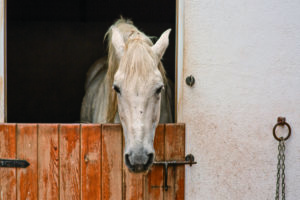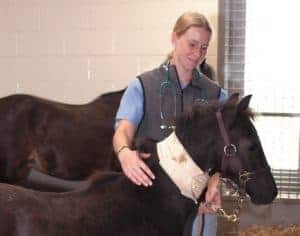When Will My Mare Foal?

It takes approximately 11 months from conception for a mare to produce a foal—emphasis on the word approximately. Anyone who’s waited up long nights for foals to arrive knows that a mare’s gestation length can vary substantially. While there are various methods caretakers can use to predict foaling, some are more accurate than others. But which is most accurate? A research team led by Mariana Diel de Amorim, DVM, DVSc, Dipl. ACT, now lecturer in theriogenology at the Cornell University College of Veterinary Medicine, in Ithaca, New York, recently set out to compare foaling prediction methods. Madonna Morrison, DVM, a recent graduate of the University of Prince Edward Island’s Atlantic Veterinary College, in Canada, presented the results at the 2017 American Association of Equine Practitioners Convention, held Nov. 17-21 in San Antonio, Texas. The team collected mammary secretions from 40 Standardbred mares starting between Day 320 and Day 330 of gestation and tested several foaling prediction methods, including:
- The calcium titration method (measuring the secretions’ calcium concentrations, which rise significantly from 72 to 24 hours before foaling);
- A digital pH meter (which measures the acidity of secretions; these are normally slightly basic—having a pH above 7—and when they drop to below 7, the mare will likely foal within 24 hours);
- pH test strips (the same concept as using a digital pH meter, but using commercially available test strips);
- Water hardness test strips (measure calcium and magnesium);
- A Brix refractometer (measures colostrum-specific gravity, which rises as mares get closer to foaling); and
- A commercially available foaling monitoring system. Diel de Amorim said the team used Foalert. “It is a transducer that is sewn onto the mare’s vulva lips and, once the foal separates the vulva lips, the transducer sends a signal to the receiver,” she said. The receiver then calls preprogrammed telephone numbers to alert attendants that the mare is foaling.
They analyzed samples from three days (Day -3) before foaling to foaling (Day 0) and found significant differences between the tests on Days -3, -1, and 0. Some key findings:
- “Both the calcium titration and pH methods (seem) to be the best methods” for predicting foaling, said Diel de Amorim;
- The foaling monitoring system alerted the team when 82% of mares were foaling, but it did not alert them about the others; it also produced “false alarms” 19% of the time.
Diel de Amorim said owners and breeding managers can use both the calcium titration and pH methods in the field, in concert with each other. “The calcium titration method that we used is the FoalWatch,” she said. These tests are fairly easy to use, she said, noting that it can take a few tests to get the hang of how to carry them out. “The pH is easier to do and cheaper,” Diel de Amorim said. “The pH strip needs to be in 0.2 increments, and you only need a few drops of mammary secretion to perform. You put the strip in the mammary secretion and read the color immediately after. The digital (pH meter) is also easy to perform.” She said any of the digital pH meters available for aquarium use will work, but you’ll also need a pH solution to ensure the meter is calibrated properly. “In our clinical practice we tend to use both the calcium titration and pH evaluation at the same time,” Diel de Amorim said. “We have mares that have had low pH and still hang on to the foal for a few days, and sometimes they will increase the calcium and still take a couple of days until they foal. For that reason, we also have the Foalert, so we use all the technologies available to make sure we don’t miss the foalings.” Still, she said, no foaling prediction method, or combination of methods, is perfect. “Mares are sneaky, and they tend to foal when everything is quiet and no people around,” she said. “We tend to start looking at a mare’s mammary gland when they are around 310-320 days of gestation and they are starting to come in at night in the barn. First-time mares (maiden mares) may not develop mammary glands until the day of or the day after they foal, so they can fool everyone.” Diel de Amorim noted that while most mares foal without incident, experiencing complications could mean the difference between life and death for the mare or foal. “Owners should consider if they feel comfortable with foaling their own mare or not, in the first place, and make sure they have a veterinarian they can call close by in case they need help,” she said. “No technology is 100% guaranteed, so we tend to use a combination of them to make sure we attend the foalings
Create a free account with TheHorse.com to view this content.
TheHorse.com is home to thousands of free articles about horse health care. In order to access some of our exclusive free content, you must be signed into TheHorse.com.
Start your free account today!
Already have an account?
and continue reading.

Written by:
Erica Larson
Related Articles
Stay on top of the most recent Horse Health news with














